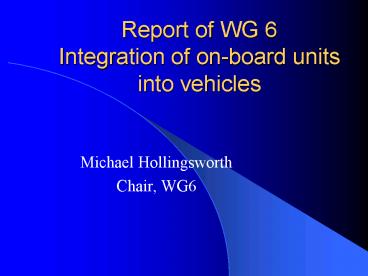Report of WG 6 Integration of on-board units into vehicles - PowerPoint PPT Presentation
1 / 23
Title:
Report of WG 6 Integration of on-board units into vehicles
Description:
Report of WG 6 Integration of on-board units into vehicles Michael Hollingsworth Chair, WG6 Content Needs of stakeholders Guiding principles Today and tomorrow ... – PowerPoint PPT presentation
Number of Views:73
Avg rating:3.0/5.0
Title: Report of WG 6 Integration of on-board units into vehicles
1
Report of WG 6Integration of on-board units into
vehicles
- Michael Hollingsworth
- Chair, WG6
2
Content
- Needs of stakeholders
- Guiding principles
- Today and tomorrow
- Solutions
- Physical incorporation
- Other issues
- Recommendations
3
Needs of Stakeholders
- Toll operators
- Users
- Vehicle manufacturers
- Equipment suppliersNeeds are not always the
same - Report tries to reconcile different needs
4
Guiding Principles
- Users treated equally
- Cost-effective solutions
- Safety and security
- HMI
- Future proof
- Flexibility
5
Today
- GNSS/CN
- Mileage counting
- DSRC
- Vehicle measurement
- Mainly single operator systems
6
The future
- New data communications
- New mobile phones
- New positioning systems
- New HMI possibilities
- Needs of existing installations
- Metal laminated windscreens in CVs
- Expansion of fleet management systems
7
Solutions
- 2009 trucks, buses and coaches
- 2011 other vehicles cars, LCV
- Reference architecture
8
Reference Architecture
9
Physical Incorporation
- Dashboard
- DIN
- removable panel
- Connectors and strength
- Compatibility power, EMC etc
- Standard layout
10
Type of fitment
11
Pre-installation requirements
- e.g.
- Operating voltage
- Nominal voltage
- Test voltage
- Overvoltage
- Operating temperature
- Storage temperature
- Diagnostic interface
12
Antennae
13
External Interfaces
- Power supply including ignition sense
- CAN bus
- Portable storage media (USB, flash card)
- Pulse Counter
14
Other Issues
- HMI many possibilities
- Ownership vehicle owner
- Up-dating
- Legal requirements Directives
- Standby
- Windscreens
15
Recommendations
- From the forgoing analysis 22 concrete
recommendations have been proposed.
16
Recommendations
- A transaction/anti-fraud security scheme needs to
be introduced that does not hinder the efficient
fitment of OBUs. - In time EEFC OBU architecture should facilitate
the full integration into vehicles - Each step in the deployment and fitment of OBUs
needs to fulfil an approval procedure, which
should be proposed by the certification centres
entitled to work on EETS on-board units. - OBUs for the EEFC should comply with a type
approval system.
17
Recommendations
- 5. The physical architecture of the OBU should
allow the integration or replacement of modules
issued from several manufacturers, without
changing the interfaces between the replaced
entity or other in-car devices. - 6. The architecture should be flexible and
extendable in terms of data storage, to include
additional EFC data elements or new software,
without changing the hardware interfaces or the
main processing unit.
18
Recommendations
- 7. The architecture should be open to include
multiple service providers and operators, thus
contributing to the development of inter-operable
services. - 8. The architecture should allow, as far as
possible, the re-use of some existing interfaces
(such as GSM/GPS antennas already installed in
approximately half million heavy trucks at
mid-2005).
19
Recommendations
- 9. The OBU shall be automotive compatible
regarding power supply, mechanical resistance,
operating temperature range, and EMC. - 10. The European Commission requests the European
Standards Organisation to develop physical and
electrical standards (including standby) for OBU
layout and connection. These standards should
also take into account requirements for fast and
easy installation of equipment. European
projects related to Directive 2004/52/CE should
make proposals for these standards.
20
Recommendations
- 11. To simplify fitment, ownership of the OBU
(but not necessarily the full cost) should rest
with the vehicle owner. - 12. To minimise the number of transmission
modules, antennae and related electronics should
be combined as much as possible between different
onboard applications, as illustrated in Figures 1
and 3.
21
Recommendations
- 13. OBUs must comply with vehicle manufacturer
requirements for example those listed page 14 in
the section of this report dealing with (pre)
installation requirements. - 14. Existing HMI should be used for OBUs that are
integrated versions fitted when the vehicle is
built. - 15. For retro-fit OBUs, European requirements
suitable for vehicle use need to be defined by an
appropriate mechanism. The project RCI should
provide inputs for this definition.
22
Recommendations
- 16. Design, fitment and interfaces need to comply
with EU legislation and HMI recommendations. - 17. An informal standard for metalised windows
exists for passenger cars a similar arrangement
for other vehicles should be developed by an
appropriate mechanism. - 18. The preferred fitment area should be a DIN
radio slot. - 19. To avoid the need for re-fitment and the
concomitant disruption, the EETS and its OBUs
should be as stable as possible over time.
23
Recommendations
- 20. To promote flexibility and ease of fitment, a
modular approach should be adopted. - 21. Software and definition file downloading
needs to be made in a cost effective way
including through portable storage media, a USB
port or the GPRS link. - 22. To facilitate fitment of OBUs, exclusion
zones should be avoided between electronic
equipment fitted in the same vehicle.































